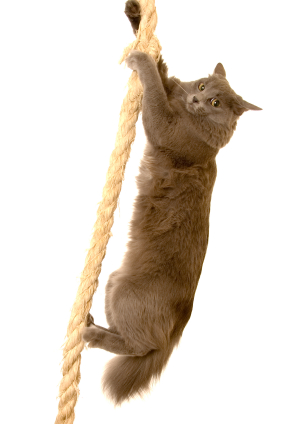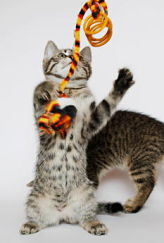Cat Clicker Training

Clicker noise for cat clicker training is based on a simple principle. The key to the clicker is that the Click! noise is paired with a food reward. Contrary to popular belief your independent free thinker is trainable. Karen Pryor, of Boston, MA. learned positive reinforcement training methods while working as a dolphin trainer at Sea Life Park In Hawaii and she introduced clicker training to the general public in 1984 through her book, Don't Shoot The Dog.
The trainer uses treats to reward the animal for a desired behavior. The Click! sound serves as a marker signal which gives the animal instant feedback about what behavior is desired. The animal quickly learns to try the desired behavior again, in order to hear the Click! and get the treat. It is easy for the average animal owner to use because it is not a system that requires a lot of practice and skill...cat clicker training just requires an open mind.
Here's how cat clicker training works...you start by introducing the clicker. That means when you are cat clicker training your pet... the Click! sound means she gets a treat. Do it again...and again...and again.
After a half dozen to a dozen repetitions, your cat starts to get the idea that Click! means Treat! You can test this by waiting until she looks away, then Click! If she immediately looks back at you in anticipation of the treat, you know she understands the concept.
You can now teach your cat to target, which means to touch an object with her nose or paw, on cue. Once she knows how to target you can use the touch behavior to teach lots of other tricks. Take a 3 foot long stick or wand about the diameter of a pencil and tape black electrician's tape around one end. This is your target stick. If you want to get fancy you can buy a collapsible target stick called "Karen Pryor Target Stick" and there are examples shown a few paragraphs below.
Since cats are naturally curious, when you offer the taped end of the stick to your cat, she will probably sniff it. "Click! the clicker and feed her a small piece of her favorite treat and if she doesn't want to sniff the stick, rub some tasty food on the end to tempt her.
Make the cat clicker training easy at first, then hold the stick further away so she has to move to it to touch it. Repeat this exercise until she is eagerly touching her nose to the stick whenever you offer it. Then start using the verbal cue, "Touch!" as she touches the stick. After a dozen or so repetitions you can start saying "Touch!" first as the cue to touch the stick, then Click! and give the treat when she does.
(Always remember that every time you Click! she gets a treat). Once she is touching the target stick eagerly and reliably, you can use it to get her to jump up on different surfaces. Hold the stick over the sofa and say "Touch! She jumps on the sofa to touch the stick. Click! Treat! You get the idea of cat clicker training and now you can get creative.
Some Cat Training Tools
You can use targeting to enhance your cat clicker training of cat tricks. Want her to sit up on cue? Hold the target stick just over her head and say "Touch!" When she stretches up to touch the stick Click! as her front paws come off the ground, then feed her the treat reward. All living things repeat behaviors that they find rewarding.
Once your cat understands that lifting her front paws off the ground
earns a Click! and a treat, she will offer the behavior more and more
willingly. Repeat until she is doing the behavior easily when you move
the target stick over her head. Now, add a verbal cue like "Sit Up!" as
she does the trick. After a dozen or so repetitions, start saying the
cue first, then moving the target stick.
Over time, you can gradually fade out the stick
"sit up" for the verbal cue alone. Once she knows the trick, you don't
have to Click! and treat every time you ask her to do it...just often
enough that she stays enthusiastic about offering the behavior on cue.
Of course, you can Click! and treat every time if you want.
You've probably noticed that I've used the word "cue" instead of "command" for cat clicker training. We don't use the verbal cue until the cat is actually doing the behavior. Before we ask her to do something, we have to figure out how to show her what we want her to do. We usually do this by using the target stick, a treat or an enticing toy as a lure. Once we know we can get her to repeat the behavior then we introduce the verbal cue to tell her what she is doing.
Cats don't speak English so a word has no meaning to the
cat until we associate that word with a behavior. There's no point in
using the word until we know that we can get her to do the behavior we
want her to associate with the word, a basic principle in cat clicker
training.
We can also use the Click! and treat to
reinforce behaviors that your cat offers of her own
accord. This is called "capturing" a behavior. Does your cat have that
cute feline habit of sitting on any piece of paper you put on the
ground? Put it on cue and teach her to "go to her spot". Just put a
piece of paper on the ground. You know that sooner or later she'll park
her furry backside on it. When she sits on it Click! and treat.
Avoid using your newspaper or you'll be sorry. My cat Coty made it impossible to read a newspaper because she parked herself on it so she got a second cat clicker training with plain printer paper.
You are
reinforcing your cat's natural tendency to sit on pieces of paper and
since repeating behaviors that are rewarding to them usually continues,
add the verbal cue "Go To Your Spot" as she is doing it. With enough
repetitions you will be able to send her to her spot on request...very
handy when you have company for dinner and you don't want her on the
dining room table licking the butter.
Simple behaviors like "sit up" are relatively easy to teach as long as you have patience. More complicated behaviors like "Turn off the Light!" will have to be shaped...this means breaking a complex behavior into small increments, and clicking and rewarding each increment until you have trained the whole thing. Possible increments for "Turn off the Light!" might be:
- 1: Touch a target with the paw. (If you already taught your cat that "Touch!" means touch with her nose, you will need another cue, "Paw" for a paw touch. Use something as a target that she will likely paw at...perhaps something shiny or wiggly. Click! and reward the paw motion using the same sequence that you did for the nose touch, until you have it on verbal cue.
- 2: Touch the "Paw" target in various locations.
- 3: Touch the "Paw" target on a chair next to the light switch.
- 4: Gradually reduce the size of the "Paw" target so your cat is actually touching the light switch. Click! and reward any touches to the light switch.
- 5: Click! and reward only more enthusiastic paw swats to the switch.
- 6: Click! and reward enthusiastic paw swats that move downward on the switch.
- 7: Click! and reward only those swats that are strong and downward enough to actually turn the light off.
In any series of cat clicker training repetitions, some of your cat's responses will be better than others. When she is touching the light switch reliably, you can stop clicking tentative touches and only click more solid pats. When she is patting routinely, sometimes, in her enthusiasm, she'll swat harder. Gradually start clicking only the harder swats. With some of those swats she'll swipe down a little. When she starts doing this, you can click only the more enthusiastic swats that move downward.
As she swipes down more often, some swipes will be strong enough to actually turn of the switch. When "Lights out" is happening consistently you can reward only those swipes that really turn the light off. Now you're ready for another process on the cat clicker training path.
This process is called "raising the criteria," and is one of the more challenging aspects of cat clicker training. If you raise the criteria too quickly, your cat may get frustrated and "quit". She needs to have lots of wins in order to stay interested in playing the game.
If she starts to lose interest, lower the criteria, give her several wins in a row, try one or two harder ones, and end the cat training session while she is still playing the game. Please note that the biggest mistake you can make is raising the criteria too quickly. If your cat seems like she's not "getting it," you're probably guilty...so slow down.
Each time you start a new cat clicker training session, begin at a level where your cat was previously performing very confidently...then slowly start raising the criteria again. Five to fifteen minutes per session is plenty. Stop each session on a high note while she is still enthusiastic, and before either of you gets frustrated...remember...training should be fun!
You can do several sessions each day, spaced a couple of hours apart. In the beginning, it's best to practice in an environment with very few distractions. Shut your other cats in another room. You want your cat focused on you, the clicker, and the treats. Now train your heart out. The things that you can teach your cat are limited only by her physical abilities and your imagination.
I recommend watching Karen Pryor's "Clicker Magic" video shown above in the Amazon box that is available in both VHS and DVD. It shows a cat being clicker trained to run an obstacle course.
Related Articles......
Return from Cat Clicker Training to Cat Health Homepage
Having trouble finding what you need? Cat Health Index & Site Map
OR
Do you have a question to ask?...Questions
OR
Do you have a cat story to share?...Simply click here to go to that page!
Copyright@2010-2020 All rights reserved.Cat-health-detective.com
This website is information only. Consult a veterinarian for medical assistance

"Like Us" on Facebook
or...
"Like Us" here




















